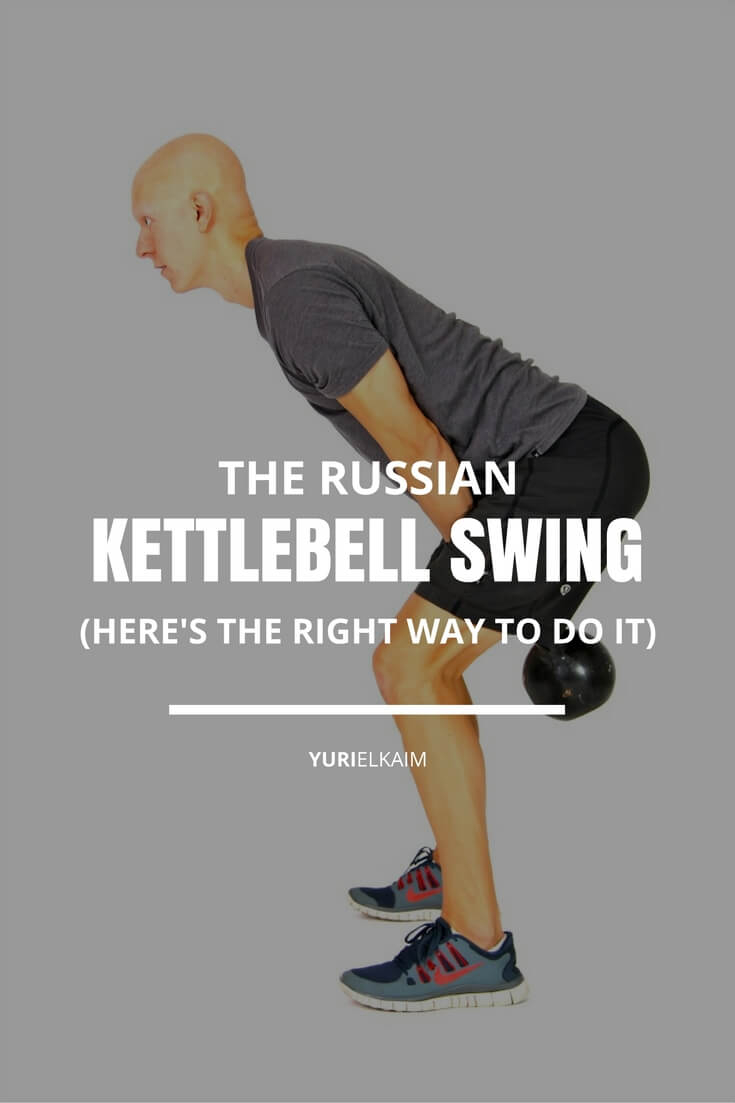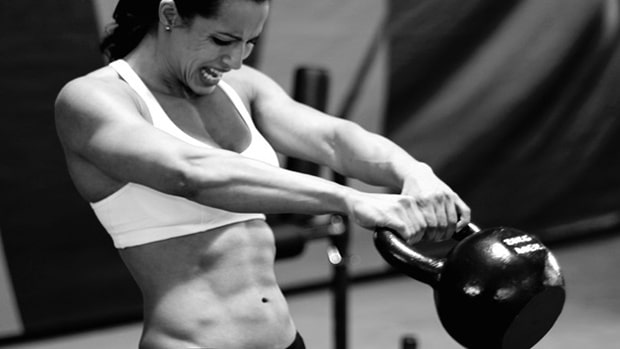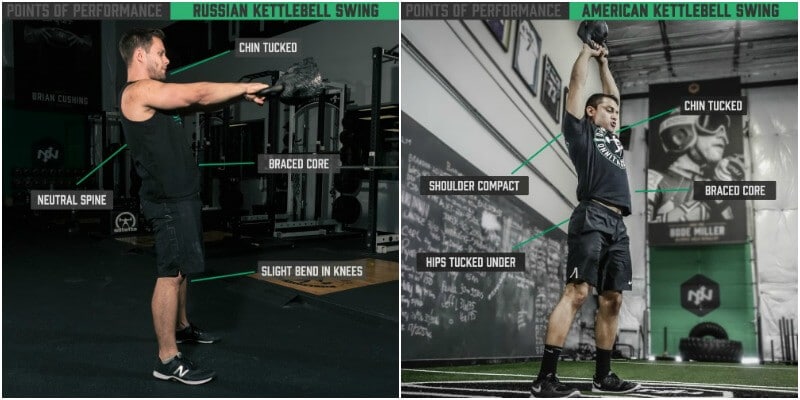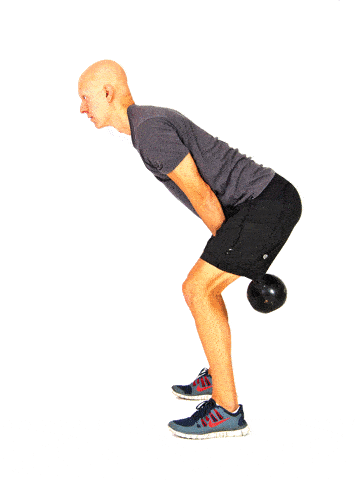In this article
While kettlebells may seem like a new addition to your gym, they’ve actually been used for hundreds of years.
Legend has it they came into use in Russia in the early 1700s, where they were used by farmers as a counterweight for crops.
Russian strongmen quickly realized how versatile they were, and started using them as an exercise weight.
Fast-forward to 2001, when Russian strength coach (and former Soviet Special Forces trainer) Pavel Tsatsouline introduced kettlebell training methods in North America by publishing his Russian Kettlebell Challenge manual.
Now, the kettlebell swing has been revived as one of the best exercises the human body can perform – and for good reason.
Kettlebell Swing Benefits
The kettlebell swing is one of those rare exercises that fits nearly every bill.
1. Full-Body Muscle Recruitment
The kettlebell swing is a fantastic full-body exercise. The power required to perform the movement requires pretty much your whole body.
The glutes, hamstrings, lats, abdominals and core, shoulders, and back are all recruited during the swing, making it one of the most comprehensive exercises you can do.
This is also important when it comes to building the power and strength needed in other movements.
That’s because most of our power to perform any forward movement stems from the posterior chain – which is the group of muscles running along your backside.
The kettlebell swing is one of the most powerful exercises to attack the posterior chain.
2. Aerobic and Anaerobic Workout
When it comes to kettlebell swings, you truly have a package deal.
On top of building lean mass, the explosive nature of the swing also gets your heart rate up into the aerobic zone and give you an amazing anaerobic workout due to the simultaneous muscle engagement.
And when it comes to calorie burn, a study conducted by the American Council on Exercise (ACE) found that during a 20-minute kettlebell workout, participants burned 13.6 calories per minute aerobically and 6.6 calories per minute anaerobically.
That totaled 20.2 calories a minute, which researchers said was “off the charts” and likened it to running a 6-minute mile (1).
This makes kettlebell swings one of the best choices for high-intensity interval training workouts, especially if you’re looking to burn fat.
3. Increases Muscular Endurance
On top of building strength and aerobic capacity, kettlebell swings are also great for building muscular endurance.
This is especially true when using a slightly lower weight with higher reps, as it lengthens the amount of time muscles are engaged.
4. Improves Low Back Pain
When performed correctly, kettlebell swings have the ability to strengthen the stabilizer muscles that wrap around our core and spine like a corset.
These muscle protect our spine from unnatural movement and injury, so strengthening them serves to keep the spine in its proper alignment. This can help you avoid low back pain by adding a muscular “cushion” of sorts, around your spine.
In fact, one study found that participants with back pain had less intense pain in their neck, shoulders and lower back after completing an eight-week kettlebell workout program (2).
5. Works Lots of Muscles at Once
Functional training involves several muscle groups at once, and most of the time, these movement mimic the natural movements of the human body.
They’re the opposite of using weight machines, which tend to stabilize weight for us, instead of letting our bodies do the work.
Functional exercises like kettlebell swings improve coordination, mobility, balance, and motor skills, as they require your full mental and physical attention.
Plus they are also functional when it comes to structuring HIIT and interval workouts, as they are easy to maneuver and use a great deal of flow-like movements.
For example, while it takes a only few seconds to set up a kettlebell swing, it takes at least double that time to properly set up a rack or other machine.
6. Increases EPOC
EPOC, or excess post-exercise oxygen consumption, refers to the amount of calories our body burns after a workout, rather than during.
HIIT and other high-intensity workouts increase EPOC due to the effort the body has to make in order to restore oxygen levels to normal and repair our muscles, all of which lead to a higher calorie burn even after we’ve left the gym.
The intensity of kettlebell swings is exactly the type of intensity needed to stimulate a higher EPOC value (or, an increase in metabolism).
Just how much of an increase? One study found a 4.2 percent metabolic increase the day following a HIIT workout, alongside an increase in fat oxidation that continued the second day following the workout (3).
In other words, researchers noted a modest increase that lasted 48 hours following the workout. Now that’s a win-win!
Russian Kettlebell Swing vs. American
The Russian Kettlebell Swing vs American (image courtesy of Onnit Academy)
The difference between the American kettlebell swing and the Russian kettlebell swing lies in the apex point of the swing.
The American swing continues past the chest and up over the head, while the Russian swing tops out at chest level.
Why does this matter?
The answer rests in the shoulders – literally.
In the American swing, the kettlebell is swung all the way up and over the head until it’s in direct alignment with the spine. This places the shoulder joint, a naturally unstable joint in the body, in a precarious position.
This is especially true when you’re using a close grip (as we are in kettlebell swings) and a decent amount of weight, as the shoulder joint is maintaining an unstable load while also taking responsibility for halting an explosive movement.
That’s why American kettlebell swings require us to use a lighter kettlebell. This can slow down the development process of the core, glutes, legs, and lat muscles.
This is where the Russian kettlebell swing shines, as it stops at chest level, allowing us to avoid loading the shoulders while also allowing us to use a heavier weight.
It’s for this reason we’re using only the Russian version of the swing, as it minimizes the risk of injury.
Russian Kettlebell Swing Form
The most obvious mistake many beginners make when attempting the kettlebell swing is rounding the spine.
Doing this shifts the workload from the glutes, legs, and core into the back, shoulders and arms. That can spell injury, especially due to the repetitive nature of the swing.
I can’t stress it enough: you want to make sure your spine stays in a straight line as you hinge from your hips.
To do this, concentrate on engaging and bracing your core throughout the movement, while also driving the weight forward using the thrust of your hips and glutes.
Resist the tendency to transfer the weight to your arms as you begin to get fatigued.
Russian Kettlebell Swing: Step-By-Step
- Begin by holding the kettlebell with both hands just below the groin, feet hip-width apart.
- Be sure your spine is neutral, not rounded forward, and your core is engaged. Think about keeping your shoulder blades slightly pinched together to avoid rounding forward.
- Now bend your knees slightly, hinge upward, and push the kettlebell into a swing using the force of your hips and glutes.
- Swing the kettlebell to chest level, avoiding letting your shoulders “creep up” to your ears.
- Let the kettlebell swing back to your starting position by hinging again at the hips, extending the kettlebell behind you.
- Repeat.
Need a video of that?
Here my good friend and StrongFirst Level 2 Kettelebell Trainer, Chris Lopez, shows you how to perfect the KB swing. Definitely worth a watch.
Kettlebell Swing Workout
One of the best things about kettlebell workouts is that they give you results while cutting your gym time in half.
Below is a kettlebell swing workout to get you started with kettlebells.
Kettlebell HIIT Workout
Complete this circuit three times, with one minute of rest between circuits. If you’re a beginner, feel free to lengthen your rest period, or add a 30-second rest period between exercises.
- Russian Kettlebell Swings – 8 to 10 reps
- Plank – 30-second hold
- Russian Kettlebell Swings – 8 to 10 reps
- Pushups – 10 to 15 reps
The beauty of kettlebells is that you can choose where you want to go heavier (staying in the 8-rep range) or lighter for an aerobic/endurance workout.
Start with a lighter weight if you’re a beginner, of course. Also, if you’re an absolute beginner, again make sure that you’re doing kettlebell swing with the correct form.
Focus on Form and Core Strength
If you’re finding it difficult to hold the correct form throughout the swing, try to focus on other core-building exercises, like planks, deadlifts, and glute bridges before jumping into kettlebell swings.
Now, without further ado, let’s get swinging!
Discover a beginner-friendly, full-body kettlebell workout by checking out The Best Kettlebell Full Body Workout Routine for Beginners.
This Workout Burns Fat
Get slimmer, fitter, and sexier with my Fat Blaster workout!
Designed to help you lose weight fast by boosting your metabolism, you’ll love the results.
The Fat Blaster includes an instructional video, workout tracker, and follow-along audio. It’s a $29 value – but it’s yours FREE!
Click the banner below to get it right now!





